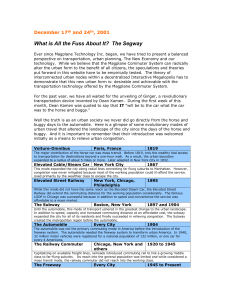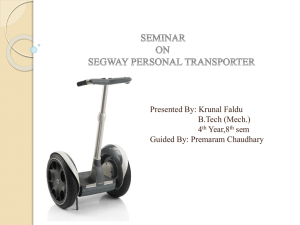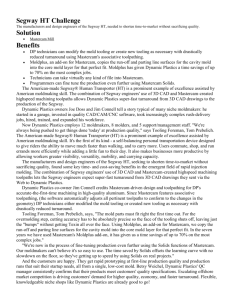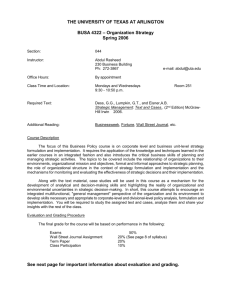Segway
advertisement
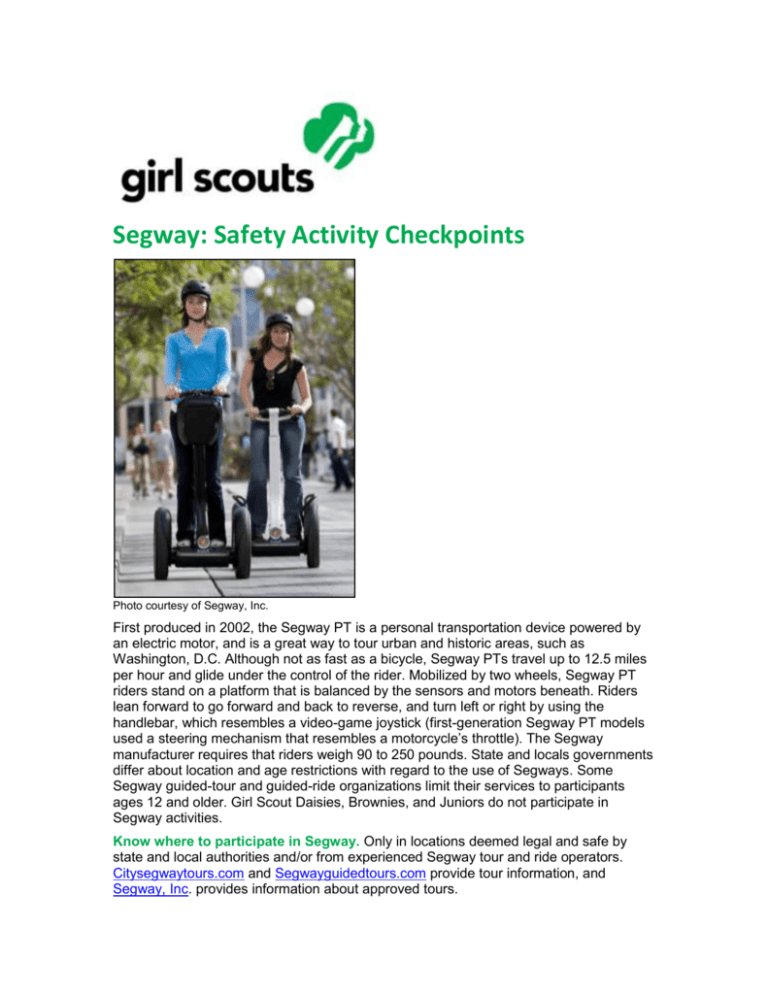
Segway: Safety Activity Checkpoints Photo courtesy of Segway, Inc. First produced in 2002, the Segway PT is a personal transportation device powered by an electric motor, and is a great way to tour urban and historic areas, such as Washington, D.C. Although not as fast as a bicycle, Segway PTs travel up to 12.5 miles per hour and glide under the control of the rider. Mobilized by two wheels, Segway PT riders stand on a platform that is balanced by the sensors and motors beneath. Riders lean forward to go forward and back to reverse, and turn left or right by using the handlebar, which resembles a video-game joystick (first-generation Segway PT models used a steering mechanism that resembles a motorcycle’s throttle). The Segway manufacturer requires that riders weigh 90 to 250 pounds. State and locals governments differ about location and age restrictions with regard to the use of Segways. Some Segway guided-tour and guided-ride organizations limit their services to participants ages 12 and older. Girl Scout Daisies, Brownies, and Juniors do not participate in Segway activities. Know where to participate in Segway. Only in locations deemed legal and safe by state and local authorities and/or from experienced Segway tour and ride operators. Citysegwaytours.com and Segwayguidedtours.com provide tour information, and Segway, Inc. provides information about approved tours. Include girls with disabilities. Communicate with girls with disabilities and/or their caregivers to assess any needs and accommodations. Learn more about the resources and information that Disability Rights Advocates for Technology provides to people with disabilities. Segway Gear Required Gear Protective helmet with properly fitting safety harness that meets the American Society for Testing and Materials (ASTM) F2416 or F1492 requirements, displaying the Safety Equipment Institute (SEI) seal Sneakers or sturdy shoes Daypack to carry personal belongings Recommended Gear Clothing appropriate for the weather Sunscreen (SPF of at least 15) and lip balm Sunglasses Prepare for Segway Communicate with council and parents. See the Introduction to Safety Activity Checkpoints. Girls plan the activity. See the Introduction to Safety Activity Checkpoints. Arrange for transportation and adult supervision. For the recommended adult-to-girl ratios please see the Introduction to the Safety Activity Checkpoints, keeping in mind that Segway use is restricted to Cadettes, Seniors and Ambassadors. Verify instructor knowledge and experience. Ensure that: The Segway instructor has experience and skill in teaching and supervising Segway PT. The instructor reviews the operating procedures with girls before riding a Segway. The experienced Segway instructor teaches participants how to ride, turn, and stop in a controlled, safe location free of obstructions and traffic. Segway PTs are ridden in pedestrian environments and not on streets. The instructor supports and spots participants when they step on and off of a Segway, and ensures that riders are comfortable riding a Segway before participating in a Segway tour or ride. Compile key contacts. See the Introduction to Safety Activity Checkpoints. Dress appropriately for the activity. Make sure girls and adults avoid wearing dangling earrings, bracelets, and necklaces that may become entangled in equipment. Prepare for emergencies. Ensure the presence of a first-aid kit and a first-aider with a current certificate in First Aid, including Adult and Child CPR or CPR/AED, who is prepared to handle cases of abrasions, sprains, and fractures. Emergency transportation is available; if any part of the activity is located 30 minutes or more from emergency medical services, ensure the presence of a first-aider with Wilderness First Aid. See Volunteer Essentials for information about first-aid standards and training. On the Day of the Segway Activity Get a weather report. On the morning of the Segway activity, check weather.com or other reliable weather sources to determine if weather conditions are appropriate. Do not ride Segways in rain or strong winds. If severe weather conditions prevent the activity, be prepared with a backup plan or alternate activity, or postpone the activity. Write, review, and practice evacuation and emergency plans for severe weather with girls. In the event of a storm, take shelter away from tall objects (including trees, buildings, and electrical poles). Find the lowest point in an open flat area. Squat low to the ground on the balls of the feet, and place hands on knees with heads between them. Use the buddy system. See the Introduction to Safety Activity Checkpoints. Practice safe Segway procedures. Ensure that the practice of riding the Segway PT is legal in the planned location of activity. Remember that, although most states allow Segway PTs on sidewalks, town and city laws may differ. Ensure the Segway riding location is safe; do not ride in traffic, on steep slopes or hills, on slippery surfaces, or on gravel, sand, or other loose surfaces. Girls are encouraged to plan details of their Segway trips. Beginners start by riding in Segway’s slowest mode. Riders do not misuse or “push” a Segway past its limits; for instance, riders do not lean forward when the Speed Limiter Alert is on, nor do they continue to ride when the Stick Shake Warning is on. Take care when turning left and right and when stopping and parking a Segway. When riding on sidewalks in urban areas, be on alert for pedestrians, doors opening, and low overhead obstructions. Give right-of-way to pedestrians, and ride Segway on right-hand side of sidewalks and paths. Do not ride a Segway over curbs; use the cutout of a curb instead. When riding a Segway, keep at least two Segway tires’ distance from another rider. Segway Links Segway: www.segway.com Segway Online: www.segwayonline.com Segway Know-How for Girls Learn about the mechanics of the Segway PT. Computers and motors in a Segway PT’s base keep the vehicle upright when powered on. To learn more about the mechanics of Segways visit Segway.com. Charge up the battery. The battery life of Segway PTs differs, depending on the model. For instance, the Segway i-Series’ maximum speed is 12.5 mph, and is capable of covering 15 to 25 miles on a fully charged battery. Batteries also recharge while riding downhill. Visit Segway for information about Segway batteries.

